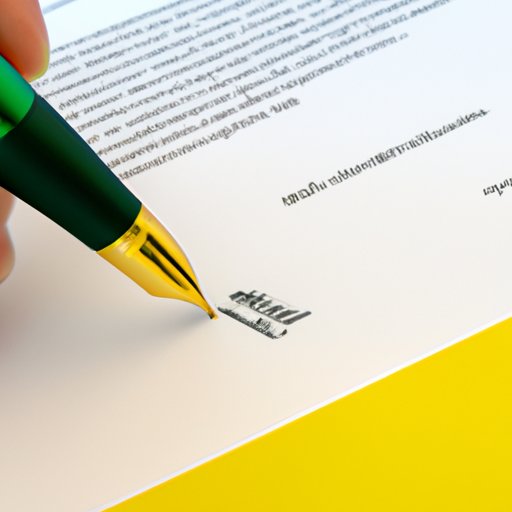I. Introduction
Learning how to sign a Word document is an essential skill for anyone who works with legal or official paperwork. Whether you are signing a contract, a letter, or an agreement, it is important to know the proper signing techniques to ensure that your signature is authentic and legally binding. This guide will cover the basics of signing, as well as more advanced techniques for adding a digital signature and customizing the signing experience to your needs.
II. The Simple Guide to Signing a Word Document: A Step-by-Step Tutorial
The most basic way to sign a Word document is by using a mouse or touchpad to create a digital signature. Here are the steps to follow:
- Open the Word document you need to sign.
- Click on the “Insert” tab on the top menu.
- Select the “Signature Line” option under the “Text” section.
- Fill in your details on the “Signature Setup” pop-up window.
- Click “OK” to add the signature line to the document.
- Click on the signature line to add your digital signature using your mouse or touchpad.
It’s important to note that this basic method is not as secure as adding a digital signature. Make sure to follow additional tips and tricks to increase the authentication of your signature.
III. How to Add a Digital Signature to Your Word Document: Tips and Tricks
A digital signature is a more secure and efficient way to sign Word documents. It is a unique electronic code that provides authenticity and integrity to the signature. Here are the steps to add a digital signature using different software:
- Use DocuSign or Adobe Sign to create a digital signature.
- Upload the Word document to the software and select the signature option.
- Follow the prompts to sign and send the document.
It’s important to protect your digital signature from being tampered with or used without your permission. Use additional methods, such as password-protecting the document or using a secure email service.
IV. Signing Word Documents: Understanding the Different Methods and Which One is Best for You
There are various ways to sign Word documents, and each method has its pros and cons. Here’s a breakdown of some of the different methods:
- Pen and paper: The traditional way to sign a document, but not as secure or efficient as other methods.
- Electronic signature pad: Provides a more authentic and secure signature, but can be costly and requires additional hardware.
- Digital signature: An electronic code that provides the highest level of security and authenticity, but requires additional software and setup.
Depending on your situation and needs, some methods may be better suited for you than others. It’s important to do your research and choose the best option for your specific circumstances.
V. Customize Your Signing Experience: Different Ways to Sign Word Documents
There are additional features and tools that can be used to customize the signing experience to your needs. Here are some ways to add more information and personalization to your signature:
- Add additional information, such as your job title or email address.
- Add a signature line to create a more authentic look.
- Use a stamp or image of your signature for consistency and simplicity.
Customizing the signing experience can enhance the professionalism and efficiency of your signature.
VI. The Importance of Signing Word Documents: Protecting Your Identity and Securing Your Data
Signing Word documents is not only important for legal purposes but also for protecting your identity and securing your data. Without proper authentication and security measures, your signature and personal information can be compromised. It’s crucial to take the necessary steps to ensure the authenticity and security of your signature.
VII. Efficient and Time-Saving Techniques: Signing Multiple Word Documents at Once
Batch signing is a time-saving technique that can help you sign multiple Word documents at once. Here are some tips to follow:
- Use software or online tools, such as DocuSign or Adobe Sign, to batch sign documents.
- Ensure accuracy and efficiency by double-checking each document before signing.
- Take note of any errors or discrepancies to avoid future errors.
Batch signing is a great way to streamline the signing process, especially when dealing with large volumes of documents.
VIII. Conclusion
Learning how to sign a Word document is an important skill that can enhance the authenticity, security, and efficiency of your documents. Whether you are using a mouse or touchpad, adding a digital signature, or customizing the signing experience, these tips and tricks can help you sign with confidence and ease. Remember to choose the best signing method for your specific needs and take the necessary steps to protect your signature and personal information.
